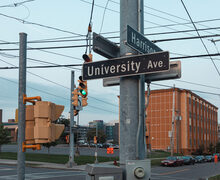Eye for an eye: 2010 shooting of local student causes ongoing surge in Syracuse violence
Neighborhood Watch Series: Part 2 of 3
After the shooting of Kihary Blue, a 19-year-old football and basketball player at Henninger High School, the city of Syracuse experienced a surge of gang violence motivated by retaliation.
Although the shooting occurred in 2010, Common Councilor Bob Dougherty said that within the last 10-15 years the amount of inner-city gang violence seems to have dramatically increased, and it has become a growing concern for many Syracuse residents and officials.
Kahari Smith, a member of the V-Not gang, shot Blue while he was in his car Nov. 26, 2010. Although Blue was not a gang member himself, passengers in his car were members of the Bricktown gang, according to a Dec. 3, 2010, article by The Post-Standard.
Blue was hospitalized after the shooting. His family chose to take him off life support Dec. 1 when it was determined that Blue could not survive his injuries, according to the article.
This, Dougherty said, sparked a chain of retaliation-motivated gang violence in the city.
‘It’s just been one payback after another since then,’ he said.
The shooting of Blue prompted Bricktown gang member Saquan Evans, 21, to shoot at 110 gang member Rashaad Walker. The shots hit Walker’s son, 20-month-old Rashaad Walker Jr., and killed him, according to a July 30 Post-Standard article.
Evans mistakenly thought the 110 gang was responsible for the shooting of Blue, according to the article.
‘Kahari Smith and V-Not shoots at Bricktown gang. Bricktown gang responds by shooting at what they thought was the perpetrators of that, that being the 110 gang. It’s doubly tragic that this 20-month-old child was shot at by members of the Bricktown gang and they didn’t even have the right gang,’ said Assistant U.S. Attorney John Katko in the article.
At any one time, Dougherty said, there are at least 25 gangs in the city, some of which have been around for at least 20 years. The problem is certainly increasing, Dougherty said.
On March 23, Demetrius Hackett shot and killed Chance Gathers in retaliation for the shooting of his brother, according to an April 10 Post-Standard article.
Hackett, 19, was arraigned on charges of second-degree murder and second-degree criminal possession of a weapon, according to the article. He is accused of shooting Gathers, 33, while Gathers was on his porch on Kenmore Avenue.
Syracuse Police Department Chief Frank Fowler said in the article that it is unknown whether the shooting is gang-related. But many of the shootings or cases of shots being heard in the city are, in fact, acts of gang violence, Dougherty said.
‘It’s almost always one gang shooting at another,’ he said. ‘All these random shots are almost always gang-related. It’s unfortunate.’
SPD Sgt. Gary Bulinski said gang violence is an issue that is being addressed in the city of Syracuse.
Bulinski said SPD does track and monitor the various gangs in the city. One of the hardest parts, he said, is trying to determine whether an act of criminal violence was actually an act of gang violence.
‘Sometimes there can be criminal incidents that occur, and we don’t know that it’s gang-related,’ Bulinski said.
But SPD does use ‘concentrated and directed enforcement’ in areas that tend to have high rates of gang violence, Bulinski said.
Another way city officials attempt to prevent gang violence is through the use of the federal Racketeer Influenced and Corrupt Organizations Act, said Lance Denno, Syracuse common councilor. The RICO Act is a law that essentially prosecutes organized crime, Denno said.
Syracuse was one of the first and only cities that used the RICO laws for the federal prosecution of organized crime, Denno said. City officials started doing this in 2003, after the prosecution of 24 gang members who were accused of using systematic violence to protect the gang’s drug trade on the Syracuse Southside.
Syracuse was one of the cities that were more successful in the use of these laws, Denno said. But, he added, gang violence is still a leading concern for the police department.
‘The bottom line is that it’s a continuing problem, one which I think the Syracuse Police Department has certainly had some success in – both tracking, investigating and prosecuting – but I’m sure they’d be the first to admit that it’s an ongoing problem,’ he said.
City officials are particularly concerned with reaching out to young adults within the school system. Denno said there are currently a number of ongoing initiatives within the Syracuse City School District, SPD and the community to help curb the alarming amount of inner-city gang violence.
Said Denno: ‘It’s a threat to … everyone in the community, not just the local community, but the entire city as a whole.’
Published on April 17, 2012 at 12:00 pm
Contact Stephanie: snbouvia@syr.edu | @snbouvia





